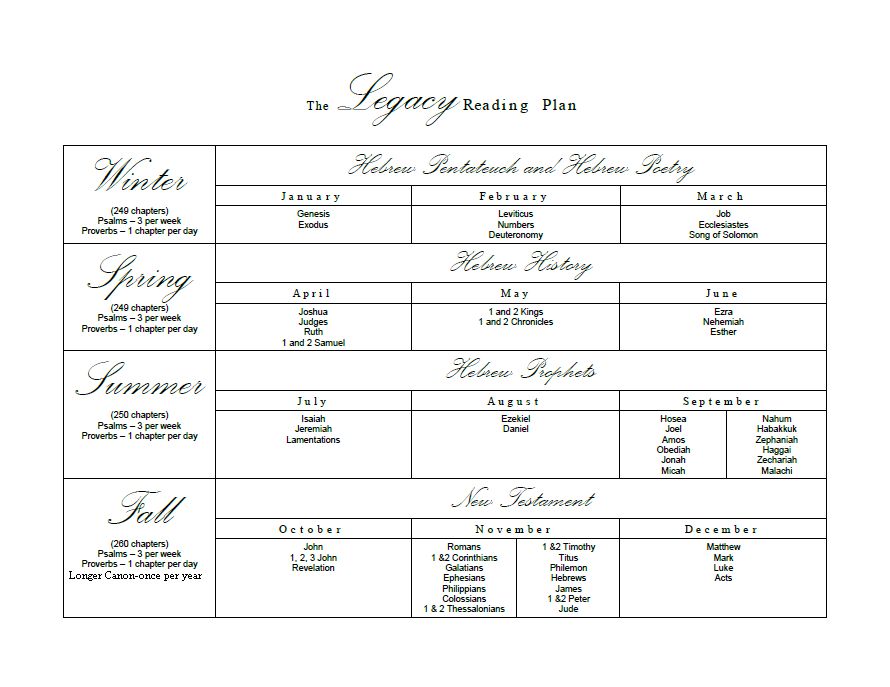
The L-E-G-A-C-Y Reading Plan Explained
Make no mistake. Reading through the Bible—particularly in a year’s time—is a daunting proposition. Thus, the Legacy Reading Plan is strategically designed to empower you to “eat the elephant” one book at a time. The format is specifically formulated to make your time in the Bible the best it can be. There’s no time like the present to engage. Consideration of the principles identified in the acronym L-E-G- A-C-Y provide a memorable framework around which reading the Bible may well become an addictive and intoxicating habit.
LOCATION. Do you have a secret place, a location where you can shut out the noise of the world and hear the voice of your heavenly Father as He speaks to you through the majesty of His Word? For some, that place may be the sauna; for others, a study. The point is we all desperately need a place away from the invasive sounds of the world so we can hear the sounds of another place, the sound of another Voice. So begin your Legacy Reading Plan by locating your secret place.
ESSENCE. The Legacy Reading Plan is unique in that it requires you to process books of the Bible rather than piecing together bits of books. The goal is to comprehend the essence of what God is communicating by reading each book as a whole. The exceptions are Psalms and Proverbs. Psalms constituted a hymnbook or devotional guide for ancient Israel and can do so for you as well. And because Proverbs is replete with principles for successful daily living, you may find it helpful to read a chapter of Proverbs each day, progressing through the entire book once a month. You may also wish to add the Longer Canon to your reading plan in that these books and readings are included in the Septuagint—the Greek translation of the Old Testament extant at the time that Jesus read the Isaiah Scroll (Luke 4:17–21). The Longer Canon’s historical details are exhilarating. For example, the Maccabean revolt chronicled in Maccabees, and celebrated by Jews during Hanukkah, is a powerful testimony to God’s fulfillment of Daniel’s prophecies.
GENRE. To understand Scripture in the sense in which it is intended, it is important to pay special attention to the genre we are reading. In other words, to interpret the Bible as literature, it is crucial to consider the kind of literature we are reading. Just as a legal brief differs from a prophetic oracle, there is a difference in genre between Leviticus and Revelation. Genre is particularly significant when considering writings that are difficult to categorize, such as Genesis, which is largely a historical narrative interlaced with symbolism and repetitive poetic structure.
AUTHOR. Just as it is essential to read through books rather than bits of the Bible, so it is helpful to read biblical authors sequentially. As such, the Legacy Reading Plan is grouped by author. This is helpful because even though biblical authors wrote “as they were carried along by the Holy Spirit” (2 Peter 1:21), their personalities and proclivities are clearly evident in their writings. For example, only John identifies Jesus as the Word, or Logos (John 1:1; Revelation 19:13). Likewise, John alone identifies Jesus as the true witness (John 5; Revelation 2), and it is John who most exploits the Mosaic requirement of two witnesses (John 8:17–18; Revelation 2).
CONTEXT. Context has an impact on how you think of one set of biblical books in relation to another. For this reason, the Epistles are read prior to the Synoptic Gospels in the Legacy Reading Plan. The didactic (teaching) principles of the Epistles provide a theological context that will help you better understand the gospel narratives. Moreover, because the book of Revelation draws heavily upon the imagery of the Hebrew prophets, the reading of Revelation is placed in close proximity to the Old Testament prophets. And because the Gospels recount the birth and ministry of Christ, the Synoptics and the book of Acts are assigned to the final month of the reading plan.
YEAR. The overarching objective of the Legacy Reading Plan is to read through the Bible once a year, every year, for the rest of your life. The reading calendar is naturally segmented into seasons and those seasons, into months. The sample layout has you starting in January, but whatever time of year you start, your focus will first be on the Pentateuch and poetry (249 chapters); second, the historical books (249 chapters); next, the prophets (250 chapters); and, finally, the New Testament (260 chapters). Each of these seasons is further broken down into months. The goal of the first month is to read through Genesis and Exodus and in the last month, the Synoptic Gospels and Acts. At times you will find yourself naturally reading ten chapters at a time and at other times, one or two. More importantly you will read the Bible just as you read other literature, not just a paragraph here or a half a chapter there.








